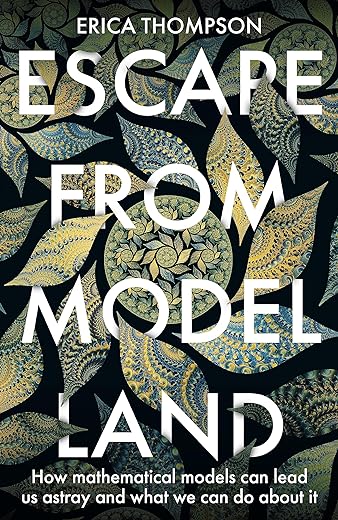Escape from Model Land: How Mathematical Models Can Lead Us Astray and What We Can Do About It
£10.11£10.99 (-8%)
‘A brilliant account of how models are so often abused and of how they should be used’ John Kay
How do mathematical models shape our world – and how can we harness their power for good?
Models are at the centre of everything we do. Whether we use them or are simply affected by them, they act as metaphors that help us better understand the increasingly complex problems facing us in the modern world. Without models, we couldn’t begin to tackle three of the major challenges facing modern society: regulation of the economy, climate change and the COVID-19 pandemic. Yet in recent years, the validity of the models we use has been hotly debated and there has been renewed awareness of the disastrous consequences when the makers and interpreters of models get things wrong.
Drawing on contemporary examples from finance, climate and health policy, Erica Thompson explores what models are, why we need them, how they work and what happens when they go wrong. This is not a book that argues we should do away with models, but rather, that we need to properly understand how they are constructed – and how some of the assumptions that underlie the models we use can have significant unintended consequences. Unexpectedly humorous, thought-provoking and passionate, this is essential reading for everyone.
Read more
Additional information
| Publisher | Basic Books, 1st edition (23 Nov. 2023) |
|---|---|
| Language | English |
| Paperback | 256 pages |
| ISBN-10 | 1529364892 |
| ISBN-13 | 978-1529364897 |
| Dimensions | 12.9 x 3 x 18.8 cm |





by MR S T
A well written book exposing the hidden biases of the use of models. It argues well for the idea that diversity of models requires also diversity of modellers, an important idea often missing from popular texts.
I felt it was surprisingly kind to economists, who it seems to me are more frequently lost in model-land than many other disciplines – and so would do well to read this book. I’d always thought that the joke about the economist assuming a can-opener to open their tin of beans related to the tendency of economists to hang on to assumptions that have been proved wrong (unlike other disciplines where this signals the need to find alternatives). In the book, though this is used more to look at the imaginary can-openers we all carry around.
I look forward to a future book which dwells a little more on the solutions to complement this book which articulates well the problems of modelling without getting lost in the minutiae of how individual models work.
by Daniel Paul
Brilliantly accessible explanation of the real world application of the ‘imperfect knowledge’ of models through the use of metaphor. Especially liked the idea of a cat that looks most like a dog.
by Alan Bland
I’ve been a fan of mathematical models throughout my career as an engineer, and they can help a lot – mainly to identify what’s important or not and show the limits of a problem. They’re an aid to judgement, not a substitute. Climate modelling seems more concerned with generating political action, so the model predictions are always catastrophic and biased to that end (e.g. Michael Mann’s Hockey Stick, which has been thoroughly de-bunked, but the media appear unaware). Maybe we need some academic courses in honesty and professionalism for modellers.
by C. H. D. Vermont
I believe this is an excellent introduction to how models work, and how they can be useful when making decisions. However, the author cautions that they can only ever be an aid, and anyone who slavishly follows their results will always find disappointment. Written in an easy and understable style, she takes the reader through all the traps along the way, and ensures we enjoy a soft landing when we escape from model land. This is the book to give to an irritating friend who claims models are science, and science is always true.
by mcdowella
This is not a book on judging models on their merits. There are hints of this in the beginning, and at least one useful reference, but it soon zooms out to consider requirements, stakeholders, and social science. There is a justifying analogy for this in “Waterfall” software development, which declares that it is not practical to certify a computer program as highly reliable by testing alone; it is also necessary to inspect the process that developed it. This analogy is not perfect, because this book recommends assembling a diverse team with the explicit goal that the personal experiences of the team members will inform the modeling process, whereas traditional software development requires a replicable process, so one not influenced by the background and perhaps the current political opinions of a changing team.
This book mostly covers single interactions, as when a single report is presented to decision-makers. It considers its effect as a single action even when, as with the IPCC, that report may be years in production or revision. Another example of a single interaction would be the modelling advice leading to the first covid lockdowns. It does not consider a process of dialogue, or of a team of modellers gaining or losing a reputation with decision makers over time. The software development precedent for this would be Agile development, where, drawing on what is now a large collection of widely used software infrastructure, a software developer can provide early versions of their program to user representatives and repeatedly modify it to take account of their reaction to it, and still deliver on time. Perhaps, if decision makers engaged in repeated dialogues with modellers who followed a consistent process, decision makers would find Model Land a less treacherous place.
by EtR
I enjoyed reading this book, which is written in a fluent and logical style, with some great examples from diverse fields. As a result it’s easy to appreciate the author’s main points about the pitfalls of moving from the modeller’s domain (‘model land’) to the real world. She offers a framework for thinking about this unavoidable divide, which should be useful to modellers and decision-makers alike. As someone who has had a foot in both camps, it challenged my thinking, which I’m sure was good for me and might be good for others too!